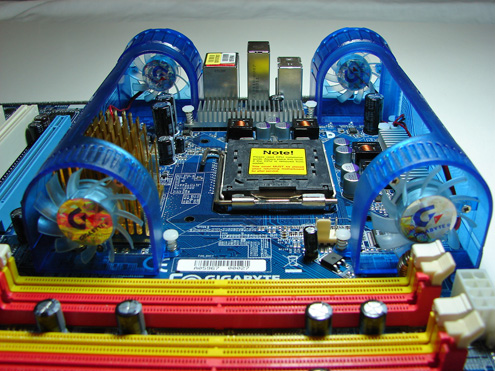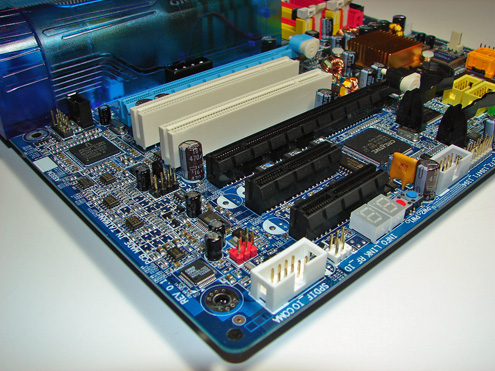Gigabyte GA-G1 975X: Will a Turbo Help the Pentium 4?
"The art of being wise is the art of knowing what to overlook."
This quote from the American philosopher and pragmatist William James sums up our first look at the Gigabyte GA-G1 975X motherboard today. This is not a full review of the board, the 975X chipset, or their capabilities but a preview of the performance potential of this combination. We will fully review this feature rich board along with others based on the soon to be released Intel 975X chipset in the very near future.
Gigabyte's new series of G1-Turbo motherboards are designed specifically for gamers and overclockers. With the release of this series Gigabyte is concentrating on providing additional bios options, increased system performance, and improved feature sets for the computer enthusiast.
The first release in this series is the Gigabyte GA-G1 975X that features the new Intel 975X chipset. This chipset is a follow-up to the Intel 955X that includes optimizations to the Intel Memory Pipeline technology, support for the upcoming 1066MHz processor system bus dual-core processors, and full support for graphic based PCI Express x16 lanes that can be configured as two PCI Express x8 slots for multi-view or GPU capability. The system currently supports ATI CrossFire technology and can support NVIDIA SLI technology in the future.

Besides the Intel 975X chipset, the main technology being introduced on this board is Gigabyte's exclusive Turbojet Technology that offers very effective heat dissipation from the processor, northbridge, and system memory sections of the board. The two front fans blow air over the system memory section with the two rear fans removing warm air from the northbridge and processor sections. Gigabyte has added additional heatsinks for the capacitors and the entire system is designed to work well with most aftermarket cooling solutions. We did not have an issue installing a Gigabyte G-Power heatsink/fan combination in our system. We will be comparing the thermal characteristics of this system to Asus's 8-phase power and fanless cooper heat pipe technology in the near future. However, after utilizing this board for the past few days we believe Asus's fanless heat exchange system is a more eloquent and desirable system for ensuring a quiet system.

The Gigabyte GA-G1 975X offers (2) physical PCI Express x16 slots, (2) 32bit PCI slots, and (2) PCI Express x4 slots. This design offers a very good balance of slots and allows for numerous add-in peripheral cards. However, in between the two x16 PCI Express slots are two 32bit PCI slots. This configuration could potentially render the first 32bit PCI slot useless when utilizing the first x16 PCI Express slot. We did not have any issues utilizing this slot with video cards containing single slot cooling systems but were unable to install a sound or network card upon installation of a NVIDIA 6800 Ultra or X850XT in the first x16 PCI Express slot.
The combination of (2) PCI Express x16 slots and (2) PCI Express x4 slots allow the capability of running up to 4 VGA cards simultaneously. Also located in this area is the debug LED display and the C.R.S. (CMOS Reload Switch) system. The C.R.S. provides a CMOS default settings retrieval and auto system reboot capability. The push button activated switch allows the user to reload the CMOS default settings when the system is unable to boot up.
Let's quickly find out if the performance of this board is worthy of the "Turbo" designation.












30 Comments
View All Comments
johnsonx - Friday, November 11, 2005 - link
Gary,From an airflow perspective, wouldn't it make more sense to have all the fans blowing the same direction? From the pictures and your description, it appears the while the fans at the backplate are blowing out, as they should, the 2nd set of fans attempt to blow air back at the memory.
The trouble is that those 2nd fans are trying to pull air against the general airflow direction in the case, and whatever air they do blow over the RAM will be warm from the CPU and other heatsinks in those platic tunnels.
I think in a real-life case, the 2nd set of fans should blow towards the back of the case, drawing cool air from the front of the case past the DIMMs, thus creating a wind-tunnel effect to more effectively draw the hot exhaust from the CPU HSF to the back fans and out of the case.
Perhaps if it can be done, you could try swapping the 2nd fans around to get them blowing the other way and do some measurements. I can't tell if it's possible from the pictures; the tunnels and fan mount brackets look like they could be one-piece. I suppose that you could reverse the polarity of the power pins to spin them backwards, but those fans don't look like they'd move much air spinning the wrong way.
Yes, I do realize that Gigabyte's Engineers must have worked on this, but I've had 'engineers' tell me riduculous things about airflow in the past that I proved wrong by simply flipping the fans around. One that comes to mind from awhile back was a KryoTech Super-G that had the back fan blowing in and the front fan blowing out... their engineers INSISTED that it was supposed to be that way, that they had tested, blah, blah, blah... after feeling the side panel getting warm and nearly burning my hand on the SCSI drive in the bay, I reversed the fans and all was well. And that was a system with NO cpu heat at all!
Airflow in an ATX case should always be front to back, bottom to top.
Gary Key - Friday, November 11, 2005 - link
This was exactly my first thought when I looked at the board, read the engineering information, and then powered on the board. My first reaction was the thermals coming off the MCH would be blown right across the memory slots and then getting swept into the power supply or back over the CPU area creating additional heat. I think I was right to some degree. ;->
However, Gigabyte is recommending and has provided pictures of their preferred CPU cooling system which consists of a cooler that is designed like their G-Power series that blows air over the entire CPU surface area. According to Gigabyte their reduction in thermals at the memory, MCH, and MOFSETs were accomplished with this combination. I am trying their cooling suggestions currently along with swapping the 40mm fans with others to blow in opposite directions. This is why I was not about to publish their test results until we had a chance to fully review the system and take our own measurements.
I have not completed testing and still have additional cooling units to try along with additional measurements from the stock heatsink/fan. My initial thoughts and test results favor the Asus 8-phase setup with the fanless heat pipe system although the Gigabyte design actually works well. I will have measurements and a final synopsis in the full article. Until then if I find something of significance I will post an update.
bldckstark - Friday, November 11, 2005 - link
I am somewhat confused by the above listed statement as it can mean several things to me.
Is there a specification for dual channel slot color coding, or are you stating your personal preference?
I know it is nitpicky, but I am curious.
Thanks for the article, you did a great job, first time or not.
Gary Key - Friday, November 11, 2005 - link
There is not a hard standard for the color designation. Most manufacturers have started color-coding the various port connectors and slots but in some cases these colors do not mean anything. With the memory slots it is now customary to color code the slots to signify which slots need to be filled to enable the dual channel memory capabilities of the board. Instead of signifying in the user's manual to utilize slot one and three or two and four for dual channel capability the quick setup sheets can now use a visual color to represent the slot numbers. It is easier to understand this way and helps when you cannot locate the user manual while you are stuck under a desk with low light conditions. ;->
The main problem is that some boards (earlier review this year) have the first and second slots the same color and slots three and four a different color yet you have to use slot one and three for dual channel. This is confusing to others and me as it is not intuitive and does not follow a "soft" standard that has developed regarding the memory slot color-coding.
johnsonx - Friday, November 11, 2005 - link
Yeah, I've found the color coding of the memory slots pretty useless, as I can never be sure whether they mean to put the two dimms in the two slots that are colored the same, or colored different. I always just figure the first two slots are one channel, and the other pair are the other channel (usually there's a gap between the two pairs, but not always).Personally, for me it makes more logical sense to have the slots the same color within a channel, so you put the two dimms into different color slots. In other words, the different color should signify a different channel. This scheme also lends itself well to single-channel boards - their slots should all be one color, signifying one channel.
That said, I can also understand the logic of making the first slot of each channel the same color, and the second slot of each channel a different color. So then you put each pair of DIMMs in the same-color slots.
Either way though, they (the MB manufacturers as a group) really ought to pick one method and stick to it. For now, I'll just ignore the colors.
rqle - Friday, November 11, 2005 - link
Can i see a pic of the backplate I/O shield? Old request, probably not even gonna get read. But it just look interesting.Gary Key - Friday, November 11, 2005 - link
Hi,I will see what I can do for you.
Marlowe - Friday, November 11, 2005 - link
Is this the final implementation of the 975x chipset? I heard there were going to be some sort of an upgrade along its lifetime, as the "current" 975x based motherboards does not support the future processors conroe and yonah? (because those two will be pin compitable right?) More PCI-Express lanes as seen in ATI's new RD580 chipset would also be nice.Gary Key - Friday, November 11, 2005 - link
Good Day,I am awaiting word from Intel about the 975X progression path and will report any findings along with additional technical information in the full article. This article was meant as a preview and since the chipset has not officially launched there were details I could not provide at this time. I fully agree that additional PCI-Express lanes would be nice. If I receive additional information from Intel before the full article is released I will update this preview.
xsilver - Friday, November 11, 2005 - link
how is putting a turbo on a scooter going to help?? ;)and i guarantee that all 4 of those tiny fans are going to either:
1) die in 4 months
2) sound like a turbocharger in 4 months
I think the next step up should actually be intergration with the case, their is just too much contstriants otherwise (especially working with the oldish ATX structure)